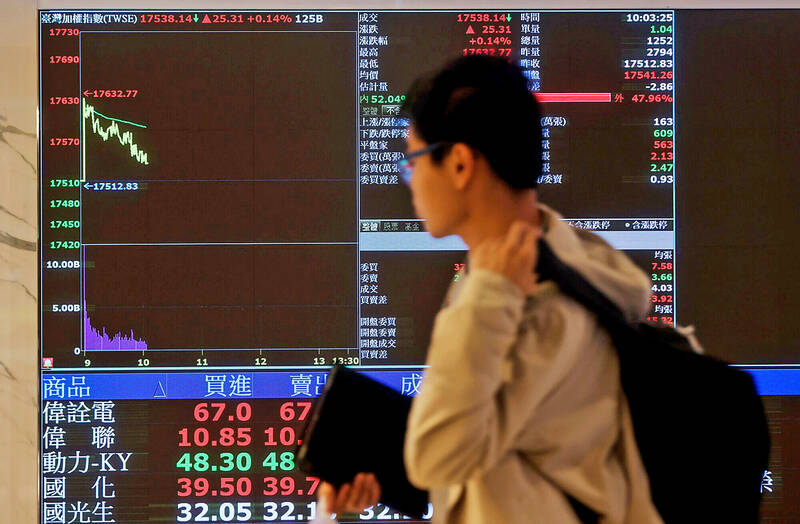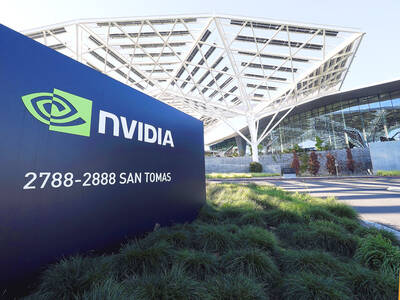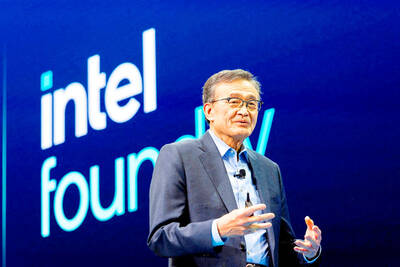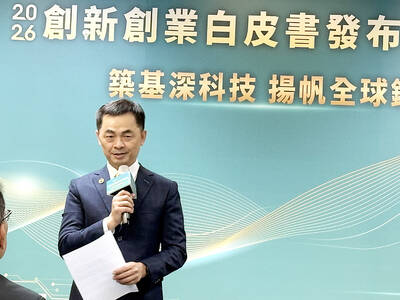Fewer retail investors entered the local stock market in the fourth quarter of last year, while more institutional investors, foreign and domestic, pushed ahead after technical consolidation in the market ended, data compiled by the Taiwan Stock Exchange (TWSE) showed on Monday.
During the October-to-December quarter, retail investors accounted for 55.96 percent of the local market’s turnover, down from 59.01 percent in the previous quarter, the exchange said in a statement.
In contrast, foreign institutional investors made up 32.74 percent of the exchange’s turnover, up 1.97 percentage points from the previous quarter, while domestic institutional investors represented the remaining 11.3 percent, up 1.08 percentage points, the TWSE said.

Photo: Bloomberg
Although market sentiment improved after November, and the TAIEX rose 1,577.07 points in the final quarter of last year, retail investors favored safer investment approaches, with dollar-cost averaging investments gaining NT$442 million (US$14.1 million) to NT$9.78 billion last month from the previous month, the exchange’s data showed.
Dollar-cost averaging is the practice of investing a fixed-dollar amount on a regular basis, regardless of the share price. It has become more popular among retail investors investing in high-dividend exchange-traded funds or local stocks with stable dividends, the exchange said.
Among retail investors, 2,973 “big players” participated in the local market in the fourth quarter, down 523 from a seven-quarter high of 3,496 in the previous quarter, TWSE data showed.
A “big player” is defined as an investor who trades at least NT$500 million in shares on the TWSE in a single quarter.
The number of “midsized players” — or retail investors with quarterly turnover of between NT$100 million and NT$500 million — decreased to 23,604 last quarter from 28,597 the previous quarter, while that of “small players,” with quarterly trading of less than NT$100 million, also fell to 4.34 million from 4.51 million, the data showed.
The exchange’s latest data are seen as an important indicator of investor confidence in Taiwanese equities, after the TAIEX’s robust performance last year, with a full-year gain of 3,793 points, or 26.7 percent.
The TAIEX yesterday closed down 199.95 points, or 1.14 percent, in line with other regional indices as concerns about geopolitical risks and Taiwan’s new political landscape after Saturday’s elections overshadowed hopes for an early US Federal Reserve interest rate cut, Capital Investment Management Corp (群益投顧) said in a note yesterday.
The index has dropped 2.14 percent so far this year.

CHIP RACE: Three years of overbroad export controls drove foreign competitors to pursue their own AI chips, and ‘cost US taxpayers billions of dollars,’ Nvidia said China has figured out the US strategy for allowing it to buy Nvidia Corp’s H200s and is rejecting the artificial intelligence (AI) chip in favor of domestically developed semiconductors, White House AI adviser David Sacks said, citing news reports. US President Donald Trump on Monday said that he would allow shipments of Nvidia’s H200 chips to China, part of an administration effort backed by Sacks to challenge Chinese tech champions such as Huawei Technologies Co (華為) by bringing US competition to their home market. On Friday, Sacks signaled that he was uncertain about whether that approach would work. “They’re rejecting our chips,” Sacks

NATIONAL SECURITY: Intel’s testing of ACM tools despite US government control ‘highlights egregious gaps in US technology protection policies,’ a former official said Chipmaker Intel Corp has tested chipmaking tools this year from a toolmaker with deep roots in China and two overseas units that were targeted by US sanctions, according to two sources with direct knowledge of the matter. Intel, which fended off calls for its CEO’s resignation from US President Donald Trump in August over his alleged ties to China, got the tools from ACM Research Inc, a Fremont, California-based producer of chipmaking equipment. Two of ACM’s units, based in Shanghai and South Korea, were among a number of firms barred last year from receiving US technology over claims they have

BARRIERS: Gudeng’s chairman said it was unlikely that the US could replicate Taiwan’s science parks in Arizona, given its strict immigration policies and cultural differences Gudeng Precision Industrial Co (家登), which supplies wafer pods to the world’s major semiconductor firms, yesterday said it is in no rush to set up production in the US due to high costs. The company supplies its customers through a warehouse in Arizona jointly operated by TSS Holdings Ltd (德鑫控股), a joint holding of Gudeng and 17 Taiwanese firms in the semiconductor supply chain, including specialty plastic compounds producer Nytex Composites Co (耐特) and automated material handling system supplier Symtek Automation Asia Co (迅得). While the company has long been exploring the feasibility of setting up production in the US to address

OPTION: Uber said it could provide higher pay for batch trips, if incentives for batching is not removed entirely, as the latter would force it to pass on the costs to consumers Uber Technologies Inc yesterday warned that proposed restrictions on batching orders and minimum wages could prompt a NT$20 delivery fee increase in Taiwan, as lower efficiency would drive up costs. Uber CEO Dara Khosrowshahi made the remarks yesterday during his visit to Taiwan. He is on a multileg trip to the region, which includes stops in South Korea and Japan. His visit coincided the release last month of the Ministry of Labor’s draft bill on the delivery sector, which aims to safeguard delivery workers’ rights and improve their welfare. The ministry set the minimum pay for local food delivery drivers at